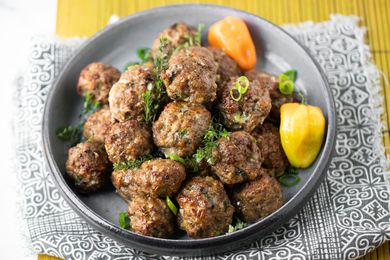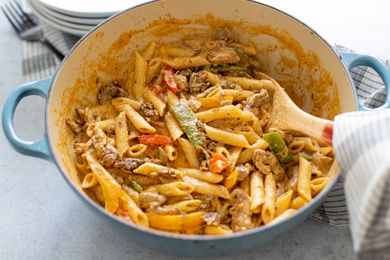:max_bytes(150000):strip_icc()/Simply-Recipes-Jerk-Seasoning-LEAD-06-72a61a4d547e490290f71aab2a0e08d4.jpg)
Simply Recipes / Alica Ramkirpal-Senhouse
Eating jerk chicken is a three part sensory experience for me. The chicken has to be brazenly hot at first bite. This is the cue that all my senses have assembled and are engaged. I keep eating until my eyes go watery. The sting remains on my tongue, but it all mellows out to an overall satiating feeling. Who knew chicken could literally bring me tears of joy?
I grew up in Queens, New York, which is just one borough that’s central to many Caribbean cultural hubs of New York City. Jamaican restaurants were easily accessible thanks to the immigrants who settled in the area and created bustling eateries, making it possible for me to consider jerk flavor as part of my culinary upbringing. My family made jerk chicken at home, but it was never like the one in the restaurants. I later realized that it had much to do with how the chicken was cooked, but also how it was seasoned.
Making My Own Jerk Seasoning
Jerk-style meat is now a regular on my weekly dinner menu. My family always used the paste version of this seasoning in the glass jar from Grace or Walkerswood brands which I continue to use today, including in my jerk meatballs. But over the years I’ve become a more skilled home cook and found making my own spice rubs in addition to other marinades quite empowering. I have more control over the salt and heat level as well as how deeply warm I want the spices. This is especially helpful when cooking for a crowd with varying tolerance for heat.
:max_bytes(150000):strip_icc()/Simply-Recipes-Jerk-Seasoning-METHOD-05-79c94bfc4a174d07b7f63bcf1e3b25e8.jpg)
Simply Recipes / Alica Ramkirpal-Senhouse
This versatile dry jerk seasoning is perfect on chicken, pork, beef, and seafood. When I want to get dinner ready with limited time, my dry rub works perfectly, especially on large cuts of meat with some fat. Meat coated in dry rubs does not require much marinating time since most of the flavor is imparted when the meat hits the cooking surface.
What Is Jerk?
The term jerk can refer to the process of cooking meat as well as the spice blend used to season the meat. The blend of spices develops a dark color when the meat is cooking, giving it that recognizable appearance.
This style of cooking originates from the 17th century colonial era when formerly enslaved people who escaped from Spanish settlements fled to the mountainous areas of Jamaica. There they encountered the Taino, a tribe of the indigenous Arawak Indians who taught the escaped slaves their technique for cooking and preserving meat.
The process involved coating meat, typically wild boar, with spices and pepper. The meat was placed in a large hole in the ground that was first layered with firewood when they were read to cook. It is believed this is where the smoky element of jerk cooking came from. They were careful to cover the pit to avoid any smoke from the cooking process alerting slave owners to their location. Read more from Jamaican-Canadian journalist Vaughn Stafford Gray as he shares about the fascinating history of jerk in this article.
:max_bytes(150000):strip_icc()/Simply-Recipes-Jerk-Seasoning-LEAD-06-72a61a4d547e490290f71aab2a0e08d4.jpg)
Simply Recipes / Alica Ramkirpal-Senhouse
Ingredients in Jerk Spice
Jerk spice is a versatile spice blend that is made in ground, paste, or marinade form. It is made from combining warm spices commonly used in everyday Caribbean cooking with aromatics and sugar to create a harmonious blend of flavor. Spices such as cinnamon, nutmeg, allspice, and clove are added along with onion, garlic, ginger, scallion as aromatics. Each cook has their own preference for what gets added to the mix and what is omitted. I like a more pronounced cinnamon, clove, and nutmeg flavor and a little less ginger, black pepper, and paprika.
Wet Jerk Marinades
Wet jerk marinades typically contain some kind of acid, like lime or vinegar, which breaks down tough fibers helping to tenderize tough, chunky cuts of meat.
:max_bytes(150000):strip_icc()/Simply-Recipes-Jerk-Seasoning-LEAD-04-e3e0dccadc4448f5b5b4a15a625807c8.jpg)
Simply Recipes / Alica Ramkirpal-Senhouse
When to Break Out Your Jerk Seasoning
When adding this to seafood and tofu, don’t overdo it since the seasoning can easily overpower anything tender. For beef, lamb, and other red meat, you can be a little more heavy handed. Chicken is my go-to meat of choice when using this rub. I like to pair it with a variety of side dishes, from Jamaican rice and peas to West Indian style chow mein or fried rice and even with potato salad or macaroni pie.
Hot Pepper Substitutions
In place of Scotch bonnet you can use dried habanero or ground cayenne pepper as the third option. I don’t recommend using dried jalapenos or serrano peppers here, since the flavor of these peppers doesn’t match the heat and taste we’re going for.
:max_bytes(150000):strip_icc()/Simply-Recipes-Jerk-Seasoning-METHOD-06-d7ada48b2b4447758f0f3123be88c44d.jpg)
Simply Recipes / Alica Ramkirpal-Senhouse
Jerk Seasoning
I like using this dried and ground Scotch bonnet in my recipe.
4 heaping tablespoons of this seasoning will season 2 pounds of bone-in chicken. For boneless meat, use 1 tablespoon per pound.
Ingredients
-
2 tablespoons (12g) ground allspice
-
2 teaspoons (5g) ground cloves
-
2 teaspoons (5g) ground cinnamon, or a 5-inch cinnamon stick
-
2 teaspoons (5g) ground black pepper
-
1 teaspoon (3g) ground ginger
-
1 teaspoon (3g) ground nutmeg
-
1 teaspoon (3g) paprika
-
1 tablespoon (6g) dried, ground Scotch bonnet
-
1 tablespoon (9g) onion powder
-
1 tablespoon (9g) garlic powder
-
1 tablespoon (16g) salt
-
2 tablespoons (25g) cane sugar
-
2 tablespoons (7g) dried thyme
Method
-
(Optional) Toast and grind the whole cloves, cinnamon, black peppercorns, and allspice:
If you have a little extra time, toasting a few of the whole spices deepens the flavor. Here’s how you can convert whole spices to ground:
- 2 tablespoons whole allspice = 2 heaping tablespoons ground
- 2 teaspoons whole black peppercorns = 2 heaping teaspoon ground
- 2 heaping teaspoons whole cloves = 2 teaspoons ground
- 1 (5-inch) cinnamon stick = 1 heaping teaspoon ground
In a dry skillet or small pot over medium-low heat, add the allspice berries, whole cloves, cinnamon stick, and black peppercorns. Move the spices around frequently by shaking the pan in a back and forth or using a spatula to turn.
When spices start to smell fragrant and make a crackling noise, about 4-5 minutes, put them in a bowl. Allow the spices to cool, then grind in a spice grinder into a fine powder.
![Cinnamon Sticks, Whole Allspice, Whole Black Pepper, and Cloves Toasting in a Pot Over an Induction Stove]()
Simply Recipes / Alica Ramkirpal-Senhouse
![Toasted Spices in a Spice Grinder Next to a Kitchen Towel for Jerk Seasoning Recipe]()
Simply Recipes / Alica Ramkirpal-Senhouse
![Ground Toasted Spices in a Spice Grinder Next to a Kitchen Towel]()
Simply Recipes / Alica Ramkirpal-Senhouse
-
Combine all the spices:
Place all the ingredients (or remaining ingredient, if you ground your own spices) in a large mixing bowl. Use a whisk or fork to crush any clusters of seasonings or sugar. Mix until the blend is all one color.
Tip
Be careful not to inhale any of the dust from the spices as you mix them. The dried Scotch bonnet peppers in particular can irritate your sinuses. Consider wearing a face mask as you mix the rub.
![Bowl With Small Piles of Jerk Seasoning Ingredients Sitting on a Kitchen Towel Next to a Spoon]()
Simply Recipes / Alica Ramkirpal-Senhouse
-
Pour into a glass jar:
Spoon the spice blend into a glass jar. You can also use a funnel to make it easier. If you do not have a funnel, sharply fold a sheet of paper in half vertically then place the spice blend on the paper holding it over the opening of the jar and slowly letting it trickle in.
![Jar of Jerk Seasoning With a Label Reading "Jerk Spice", and in the Surroundings, a Kitchen Linen and a Bowl With Whole Allspice and Cinnamon Sticks]()
Simply Recipes / Alica Ramkirpal-Senhouse
-
Store:
Store in a cool, dark, moisture-free place (like your kitchen cupboard versus in a spice rack on your counter). For the freshest flavor, the jerk seasoning is best used within 6 months.
Tip
When you open the jar your spice blend is stored in and the scent hits you straight away, and possibly makes you sneeze, the spice mix is still good to go. If you have to inhale too much to get a good measure on how it smells, your spice mix has most likely lost its flavor and potency. It will also have a sort of stale smell. The color wouldn’t be as vibrant either.
-
Use:
When using this seasoning on meat, first rub the meat with a thin layer of oil or butter, then rub the dry seasoning all over.
Love the recipe? Leave us stars and a comment below!
![Chicken Legs Pieces Rubbed in Jerk Seasoning Laying in a Aluminum Sheet Wrapped Baking Pan]()
Simply Recipes / Alica Ramkirpal-Senhouse
![Plate of Jerk Chicken Thighs on a Kitchen Towel]()
Simply Recipes / Alica Ramkirpal-Senhouse
| Nutrition Facts (per serving) | |
|---|---|
| 13 | Calories |
| 0g | Fat |
| 3g | Carbs |
| 0g | Protein |
| Nutrition Facts | |
|---|---|
| Servings: 24 | |
| Amount per serving | |
| Calories | 13 |
| % Daily Value* | |
| Total Fat 0g | 0% |
| Saturated Fat 0g | 0% |
| Cholesterol 0mg | 0% |
| Sodium 260mg | 11% |
| Total Carbohydrate 3g | 1% |
| Dietary Fiber 1g | 2% |
| Total Sugars 1g | |
| Protein 0g | |
| Vitamin C 1mg | 3% |
| Calcium 16mg | 1% |
| Iron 1mg | 3% |
| Potassium 32mg | 1% |
| *The % Daily Value (DV) tells you how much a nutrient in a food serving contributes to a daily diet. 2,000 calories a day is used for general nutrition advice. | |
:max_bytes(150000):strip_icc()/Simply-Recipes-Jerk-Seasoning-METHOD-02-86c3b349239840ea97553584418f7c89.jpg)
:max_bytes(150000):strip_icc()/Simply-Recipes-Jerk-Seasoning-METHOD-03-bf29ed68f0af441fbc2e77f7252b3c8b.jpg)
:max_bytes(150000):strip_icc()/Simply-Recipes-Jerk-Seasoning-METHOD-04-3acc4c53658843519577adbed6e9f5e1.jpg)
:max_bytes(150000):strip_icc()/Simply-Recipes-Jerk-Seasoning-LEAD-01-c25add36d1c94cb290978d2372472f12.jpg)
:max_bytes(150000):strip_icc()/Simply-Recipes-Jerk-Seasoning-LEAD-09-a8347981f84e4a329b5127eb231d7016.jpg)
:max_bytes(150000):strip_icc()/Simply-Recipes-Jerk-Seasoning-LEAD-05-f79f39f10e274be6a5dc0de29e9b963a.jpg)
:max_bytes(150000):strip_icc()/Simply-Recipes-Jerk-Seasoning-LEAD-08-831d6a4d4acf47ab90dbe0346683a452.jpg)


